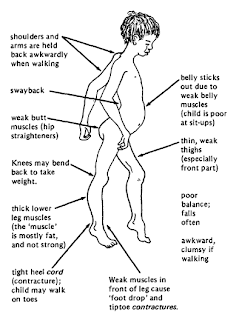What is it?
Cystic Fibrosis is a medical disorder that causes thick mucus
build up in the lungs. Normally, this
mucus is brought up to the pharynx of the throat and either spat out or
swallowed. Build up of mucus can block
airways and result in lung infections.
It also can cause mucus build up in the pancreas and block the secretion
of digestive enzymes, leading to digestive problems.
How is it inherited?
Cystic Fibrosis is an autosomal recessive gene carried in 1
out of 39 Caucasians. It takes two
defective genes for cystic fibrosis to occur.
Most of the time cystic fibrosis is detected early in life, around the
age of 2. In milder cases, people may
not be diagnosed until ages as late as 18.
How does it work?

People with cystic fibrosis have a mutated gene that codes
for a protein that transports Cl
- ions in various parts of the
body. Cl
- is very important
in many body systems. The protein is
called the cystic fibrosis transmembrane conductance regulator (CFTR). CFTR channels help to create a watery layer
that lines the outer walls of the trachea and bronchi. It does this by transporting directly
transporting Cl
- and indirectly transporting Na
+ into the
lumen (the inside) of the trachea and bronchi.
Because water often follows ions into and out of cells in order to
maintain ion concentrations, a process called osmosis, water is brought into
the lumen. This watery mixture of Cl
-
and Na
+ is called saline. It
provides a surface for mucus (which acts to collect dust and other foreign
particles) to “float” over as it is transported in an escalator-like fashion out
of the lungs. Without this layer of
saline for the mucus to float on, mucus can build up in the lungs, block
airways, and provide a breeding ground for infections.
CFTR channels are also important in the pancreas and have
similar functions. Without them, mucus
build up in the ducts of the pancreas can prevent digestive enzymes made in the
pancreas, from reaching the intestines.
Prognosis?
Without treatment, cystic fibrosis is lethal. Mucus build up can prevent proper ventilation
and not allow the digestive system to function properly. So far, there is no “cure all” for cystic
fibrosis. The average lifespan of
someone with cystic fibrosis is about 38 years old. A patient may be in and out of the hospital
throughout their life and may have many different routines they have to go
through and pills they have to take to be able to live.
Treatment?
Kalydeco
o
Pill for people 6 and older which helps the CFTR
protein to function. This drug was approved
in January by the FDA.
o
It is the first to address the underlying cause
of the disease and not just the symptoms.
o
The drug only works with people with the G551D
mutation of the gene.
·
Postural drainage and percussion
o
Helps to free up mucus in the lungs by pounding
on the chest or back and then coughing up the freed mucus
o
This is also done with special vests that fill
with air and vibrate the chest cavity and special hand held hammers that can be
used to free mucus in a specific spot in the lungs.
 ·
·
Inhaled medications that act as mucus thinners
·
Antibiotics to treat infections often caused by
mucus build up
·
Hypertonic saline mists that help to free up
mucus in the lungs
·
PICC lines which allow a direct line into the
bloodstream to allow intravenous medication.
·
Proper nutrition
 o
o
People with cystic fibrosis have a difficult
time gaining weight due to the inability of the digestive system to metabolize
food properly
o
Often people with cystic fibrosis have to eat
several thousand calories a day to try and maintain proper metabolism.
o
Supplements of different vitamins are often
taking
o
To allow proper digestion, people with cystic
fibrosis take synthetic enzymes to help break down the food they eat
·
Lung transplantation is possible if lung
function is greatly reduced
Research is being done in gene therapies to replace the
missing or dysfunctional CFTR gene.
Sources:
http://www.ncbi.nlm.nih.gov/pubmedhealth/PMH0001167/
http://www.cff.org/treatments/Therapies/
Silverthorn, D. Human physiology an integrated approach. 6th. Pearson, 2012. Print.
 The trait is an autosomal dominant trait passed down from
parents on chromosome 17. Children born
to an affected parent have a 50% chance of getting the disease. If both parents carry the trait, all their
children will carry the trait. Mutations
can arise however during embryonic development without having any affected
parents.
The trait is an autosomal dominant trait passed down from
parents on chromosome 17. Children born
to an affected parent have a 50% chance of getting the disease. If both parents carry the trait, all their
children will carry the trait. Mutations
can arise however during embryonic development without having any affected
parents.












